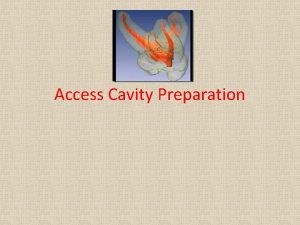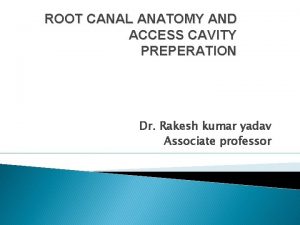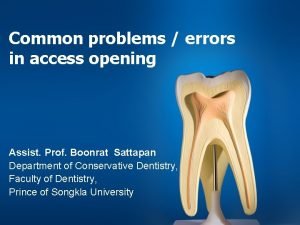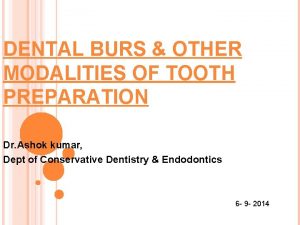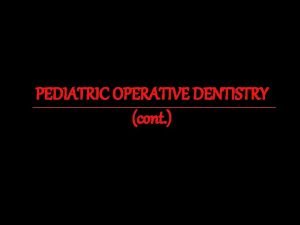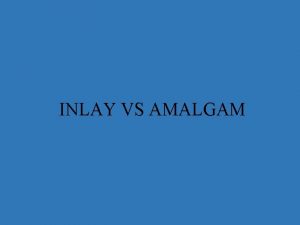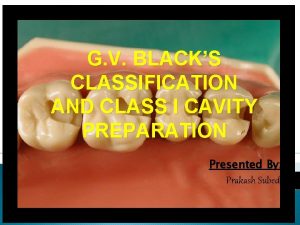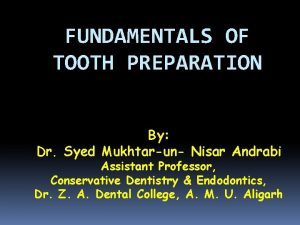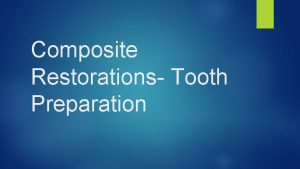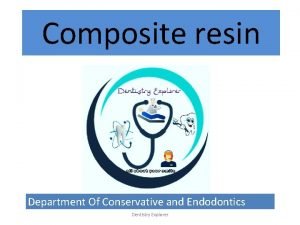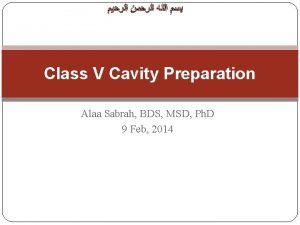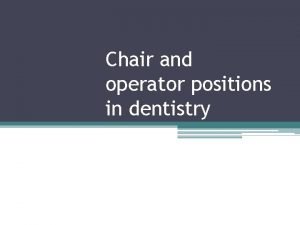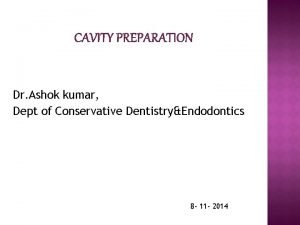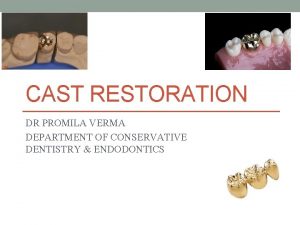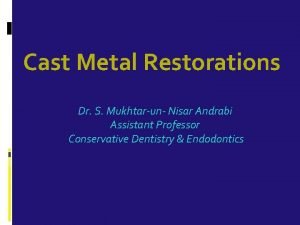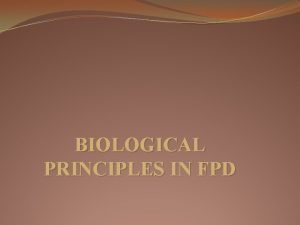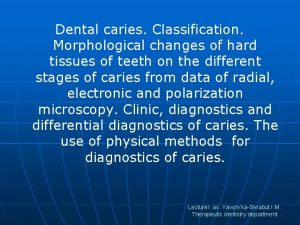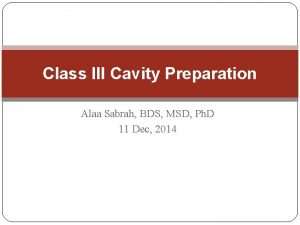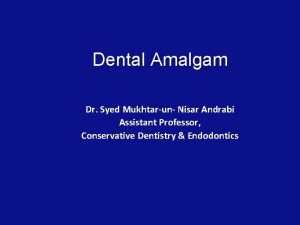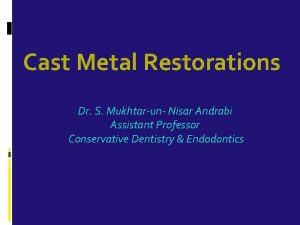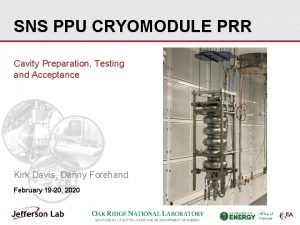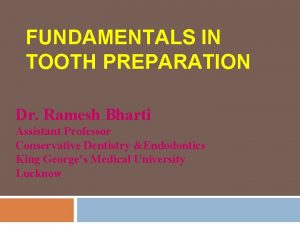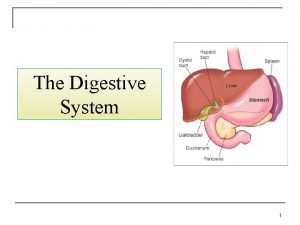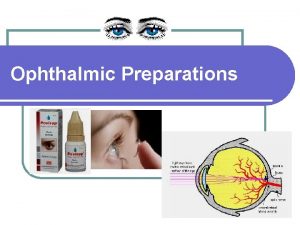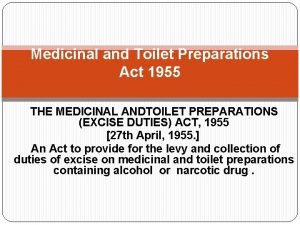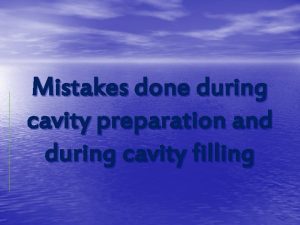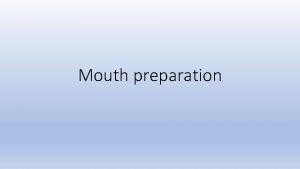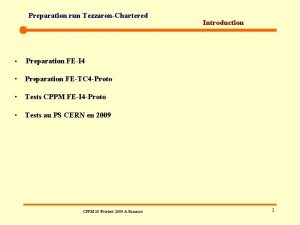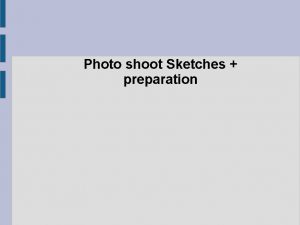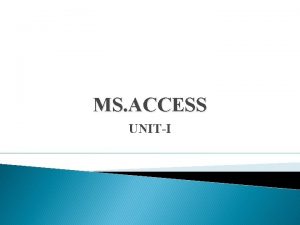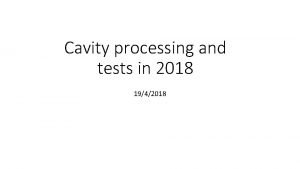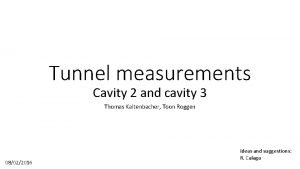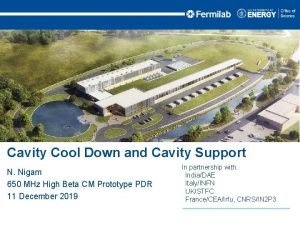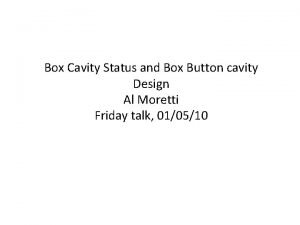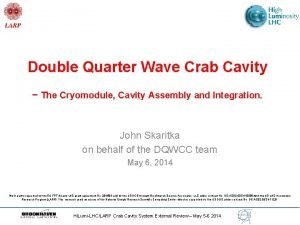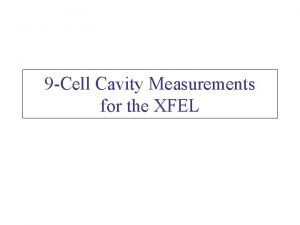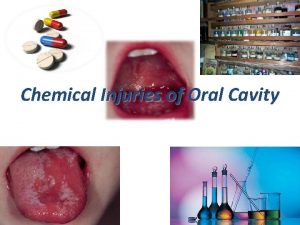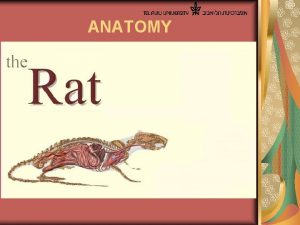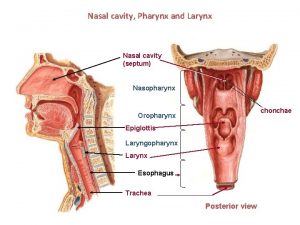Access Cavity Preparation Contents Definition What is an














































- Slides: 46

Access Cavity Preparation

Contents • • • Definition What is an ideal access Principles Instruments used Guidelines for access preparation Laws of access cavity preparation Procedure Access cavity of maxilary and mandibular teeth Management of difficult cases Recent concept conclusion

Definition Access cavity preparation is defined as endodontic coronal preparation which enables unobstructed access to the canal orifices, a straight line access to the apical foramen, complete control over instrumentation and accommodate obturation technique.

A PROPER CORONAL ACCESS FORMS THE FOUNDATION OF PYRAMID OF ENDODONTIC TREATMENT

A PREOPERATIVE PERIAPICAL RADIOGRAPH IS A MUST , PRIOR ACCESS CAVITY PREPARATION RADIOGRAPHS HELP IN KNOWING: Morphology of tooth Anatomy of root canal system Number and length of canals Branching of canal system Position and depth of pulp chamber Position of apical foramen As well, calcification, resorption present, if any

What is an ideal access cavity? • Improved instrument control • Improved obturation Straight line access • Ensure proper debridement • Improve visibility • Locate canal orifices Complete deroofing of pulp • Prevent teeth discoloration due to pulp remnants chamber • Avoid weakening of remaining tooth structure Conservation of tooth structure

Principles • Regardless of the tooth, there are three phases in the preparation of the access cavity: Ø Penetration Ø Enlarging Ø Finishing

Instruments for access cavity preparation ACCESS OPENING BURS They are round burs with 16 mm bur shank (3 mm longer than standard burs)

• ACCESS REFINING BURS These are coarse grit flame shaped , tapered round and diamonds for refining walls of access cavity preparation

SURGICAL LENGTH BURS MUNCE DISCOVERY BURS MULLER BURS Other burs used

Guidelines for access cavity preparation

Laws of access cavity preparation LAW OF CENTRALITY LAW OF CEMENTO ENAMEL JUNCTION LAW OF CONCENTRICITY LAW OF COLOR CHANGE LAW OF SYMMETRY LAW OF ORIFICE LOCATION

Laws of access cavity preparation LAW OF CENTRALITY Floor of pulp chamber is always located in the center of tooth att he level of cementoenamel junction LAW OF CONCENTRICITY Walls of pup chamber are always concentric to external surface of tooth at the level of CEJ. This indicates anatomy of external tooth surface reflects the anatomy of pulp chamber LAW OF COLOR CHANGE Color of pulp chamber floor is darker than the cavity walls. LAW OF SYMMETRY Canal orifices are equidistant from a line drawn in mesial and distal direction through the floor of pulp chamber. LAW OF ORIFICE LOCATION Canal orifices are located at the junction of floor and walls, and at the terminus of root development fusion lines.

Access cavity

PROCEDURE Removal of caries/defects/restorations Direct round bur perpendicular to the lingual surface at its center and then parallel to long axis , until a drop in effect-i. e pulp chamber entry Deroofing of the chamber completed by working inside out Locate the canal orifices using endodontic explorer Remove the liungual shoulder using GG drills/Orifice enlargement Straight line access/Refining access

Maxillary central incisors üOutline form-The inverted-triangular shaped access cavity is cut with its base at the cingulum to give straight line access. üWidth of base depends on distance between mesial and distal pulp horns. üShape may change from triangular to slightly oval due to less prominent pulp horns in older individuals.


Maxillary lateral incisors q. Shape of access cavity similar to maxillary central incisors, except that üSmaller in size üWhen pulp horns are present, shape of access cavity is rounded triangle üIf pulp horns are missing, shape is oval

Maxillary canine Shape of access cavity üNo pulp horn üAcess cavity is oval in shape with greater diameter labiopalatally

Maxillary first premolar Oval shaped acess cavity-The two horns are situated just within the peaks of their cusps. The orifices of the two canals are also slightly more within the horns. Thus, one can generally prepare a good access cavity without involving the cusps.

Maxillary second premolar Ovoid shape of access cavity

Maxillary first molar ü Shape of pulp chamber – rhomboid; ü Palatal canal orifice located palatally, mesiobuccal canal orifice located under mesiobuccal cusp, distobuccal canal orifice located slightly distal and palatal to mesiobuccal orifice. ü A line drawn to connect all three orifices forms a triangle- molar triangle

LEUBKE showed there is no need of extenstion of entire wall , he recommended extension of only that portion of the wall were extra canal is present , resulting in a clover leaf appearance in outline form- shamrock preparation.

Maxillary second molar üMb 2 less likely to be present üThree canals form a rounded triangle with base towards buccal side. üMesiobuccal orifice is located more towards mesial and buccal than first molar.

Maxillary third molar • Alavi et al. found that 50. 9% of third maxillary molars had three separate roots of which 45. 5% had two or more canals in the mesiobuccal root. Ø About 45. 7% had fused roots Ø 2% had C-shaped canals Ø 2% had four separate roots • Modifications must be made in accessing these teeth compared to first and second molars to accommodate these anatomical variations.

Mandibular incisors Access cavity of mandibular central and lateral incisors is almost similar üShape is long oval with greater dimensions directed incisogingivally

Mandibular canine Shape of acces opening similar to maxillary canineoval, but, üSmaller in size üRoot canal outline narrower in mesiodistal dimension üTwo canals may be present

Mandibular first premolar • Oval acess cavity, wider mesiodistally • Presence of 30 degree lingual inclination of crown to root, hence starting point of bur should be half way up the lingual incline of buccal cusp.


Mandibular second premolar • Similar to mandibular first premolar • Enamel penetration initiated in central groove dueto small lingual tilt • Ovoid acess opening is wider mesiodistally

Mandibular first molar üThis tooth most frequently requires endodontic treatment. üThe access cavity, which should not be triangular, rather trapezoidal or quadrangular with rounded corners. üThe classical triangular shape would hamper the identification of the second distal canal.


Mandibular second molar üThe access cavity of this tooth is started from the central fossa, and it is created according to the same rules used for the first molar. ü Because of the slight distal angulation of its roots, the access cavity can, however, be less extensive in this case. üThe shape of the access cavity depends on whethere is one, two, three, or four canals; it may be round to oval, triangular, or quadrangular

C shaped canal The incidence of C-shaped canals is reported to be highestin the mandibular second molar. THE MAIN ANATOMIC FEATURE OF C SHAPED CANALS IS THE PRESENCE OF A FIN OR WEBconnecting the individual root canals. The ‘‘C-shaped canal’’ by Cooke and Cox in 1979. This canal shape results from the fusion of the mesial and distal roots on either the buccal or the lingual root surface. 3

Mandibular third molar • The lower third molar may require endodontic therapy for the same reasons as the upper third molar. When it is the last distal abutment, this tooth acquires great importance. The most varied and bizarre root morphology can correspond to an almost normal coronal appearance. Nonetheless, this tooth can also be treated successfully by endodontic means. The same rules that apply to the other lower molars also hold for its access cavity.

Radix entomolaris and radix paramolaris • Supernumery roots in mandibular molars • Radix entomolaris: Presence of an additional disto lingual root in mandibular molars; extra root on the lingual side. • Radix paramolaris: presence of additional disto buccalroot in mandibular molars; extra root on buccal side. First reported by De Moor et al in 2004

Clinical management of difficult cases For treatment of teeth with abnormal pulpal anatomy following are required: GOOD QUALITY RADIOGRAPHS MAGNIFICATION KNOWLEDGE OF CLINICAL ANATOMY COLOR OF PULPAL FLOOR EXTENSION OF ACCESS CAVITY

Cases with extensive restorations üIf extensive restorations are marginally intact, then access cavity can be cut through them • Porcelein restorations. Diamond burs • Metal crowns-Fine cross cut metal carbide bur üIf possible , complete removal of extensive restoration allows most favourable access ü In case of an access cavity cut through restorations following can occur • Coronal leakage • Poor visibility and accessibility • Canal blockage • Misdirection of bur penetration

Tilted angulated crowns • Preperative radiographs should be thoroughly assessed • If not taken care followin may occur • Failure to locate canals • Gouging of tooth structure • Procedural accidents such as Ø Instrumrent seperation Ø Perforation Ø Improper debridement of pulp space

Calcified canals • Calcifications in the pulp space are very common • Obliteration of pulp space may be partial or complete by pulp stones • Special ultrasonic tips used • Avoid overcutting of dentin to prevent weakening of tooth structure • At first indication of canal, Introduce the smallest instrument first gently (with passive motion rotational and apical) • Use of chelating agents is also helpful(overuse may result in perforation)

SCLEROSED CANALS • Dyes can be used to locate sclerosed canals • Precise dentin removal using ultrasonic tips advised • Long shank low speed no 2 round burs also used

Teeth with no or minimal crown • Evaluate preoperative radiograph to assess root angulation and depth of penetration • Rebuild tooth structure prior endodontic procedures, if required

RECENT ADVANCES IN CONCEPT OF ACCESS OPENING Many times straight line access leads to severe loss of stategic tooth structure which may be required for the strength of crown Atleast 2 mm of of dentin thickness should be present between external tooth surface and the endodontic access at the finish line The dentin near the alveolar crest is irreplaceable An area of 4 mm above and below crestal bone is important for ferrule, strength of tooth in cervical area, so it should be always conserved maximally GG drills are non end cutting and self centering , so care must be taken to avoid strip perforation or overcutting at furcation area Pulp chamber should not be completely deroofed ; some of the roof is preserved all around the periphery of the tooth which is also called soffit to avoid damage to the lateral walls

conclusion An error in access cavity preparation would compromise all subsequent work. This preliminary step permits localization, cleaning, shaping, disinfection, and three-dimensional obturation of the root canal system. Thus the success of the endodontic treatment depends entirely on precise, proper execution of this step.

Reference sited • Text book of endodontics-Nisha Garg. Amit Garg(3 rd edition) • Pathways of pulp-stephen cohen(9 th edition) • British Dental Journal 197, 379 - 383 (2004) • Sch. J. App. Med. Sci. , 2014; 2(5 B): 1613 -1617 • Access Cavity and Endodontic Anatomy, by Arnaldo castellucci, m. d. , d. d. s. • Grossman endodontic practice-eleventh edition

Thank you for your attention!!
 Dorsal cavity diagram
Dorsal cavity diagram Shape of access cavity in maxillary first molar
Shape of access cavity in maxillary first molar Cementodentinal junction
Cementodentinal junction Access lower 7
Access lower 7 Dental burs sizes
Dental burs sizes Body cavities
Body cavities Basic anatomy terminology
Basic anatomy terminology Peritoneal cavity meaning
Peritoneal cavity meaning What is the greater omentum
What is the greater omentum Isthmus of tooth preparation
Isthmus of tooth preparation Inlay definition dental
Inlay definition dental Cavosurface angle
Cavosurface angle Class 4 cavity preparation walls
Class 4 cavity preparation walls Slot preparation
Slot preparation What is cavosurface margin
What is cavosurface margin Mount and hume classification
Mount and hume classification Class v cavity preparation
Class v cavity preparation Chair position for cavity preparation
Chair position for cavity preparation Undermined enamel
Undermined enamel Circumferential tie in inlay
Circumferential tie in inlay Cast restoration definition
Cast restoration definition Path of insertion fpd
Path of insertion fpd Gj mount classification
Gj mount classification Class 4 cavity preparation walls
Class 4 cavity preparation walls Proximal retention locks
Proximal retention locks Skirt in cast metal restoration
Skirt in cast metal restoration Test cavity preparation
Test cavity preparation Initial tooth preparation stage
Initial tooth preparation stage Terminal access controller access control system
Terminal access controller access control system Terminal access controller access-control system
Terminal access controller access-control system Parietal peritoneum
Parietal peritoneum Production preparation process
Production preparation process Preparing food
Preparing food Preparing food definition
Preparing food definition Mental preparation meaning
Mental preparation meaning Describe watershed
Describe watershed Ophthalmic preparation definition
Ophthalmic preparation definition Define bottle feeding
Define bottle feeding Medicinal and toilet preparation act was implement on
Medicinal and toilet preparation act was implement on Colloids in food
Colloids in food What does a career portfolio look like
What does a career portfolio look like Deep perineal pouch contents
Deep perineal pouch contents Febrile non hemolytic transfusion reaction
Febrile non hemolytic transfusion reaction Febrile nonhemolytic transfusion reaction
Febrile nonhemolytic transfusion reaction Superior mediastinum contents
Superior mediastinum contents Femoral triangle anatomy
Femoral triangle anatomy Middle mediastinum: contents mnemonic
Middle mediastinum: contents mnemonic

